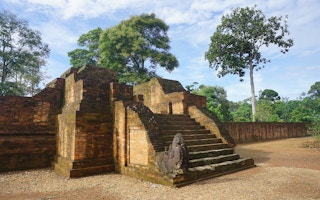Along the banks of the Batanghari River on the Indonesian island of Sumatra, thick black coal dust billows from mountainous stockpiles belonging to the coal company PT Tegas Guna Mandari (TGM).
For Zalmiati, a 42-year-old woman from Muara Jambi village, the sight of coal dust in the air is nothing new. The dust, which gets worse during the dry season, blows into her home and covers the floor, the walls, and even the cooking utensils inside her pantry.
“The drinking water, if it hasn’t been completely covered, will be contaminated with coal dust,” Zalmiati says. “If we want to eat, the glasses, plates, they must first be dipped in water. If not, they are all covered in coal.”
She blames pollution from the stockpiles for a persistent cough, which also worsens during the dry season. “I’ve already received various treatments, but … I am still not healthy. People say this cough is from the coal dust.”
Her neighbor, Maryani, echoes her concerns. “Even if the door is closed, the dust gets in,” she says. She runs her fingers along the window; they come away black with coal residue. She says she also believes the stockpiles are causing health problems in the village, where children as young as four years old have experienced months-long coughs.
Companies have been stockpiling coal in this part of Sumatra’s Jambi province since the late 1980s, collecting it from nearby mines to be sold on locally and for export. The number of such stockpiles increased rapidly in the 2000s with the arrival of companies like TGM, which received its permit to operate in Jambi’s Muara Jambi district, home to the village of the same name, in 2008. In Muara Jambi village alone, there are more than 200 families living in close proximity to open coal stockpiles, and a similar situation exists in nearby villages.
Local government officials and NGO experts agree that coal may be contributing to the high numbers of acute respiratory infections seen in the area, although pollution from forest and land fires is believed to be the primary culprit.
Threat to the Muaro Jambi temple compound
In addition to health concerns, residents are worried about the impact the coal dust may be having on the Muaro Jambi temple compound. This Hindu-Buddhist complex, which stretches through several villages along the banks of the Batanghari River, is believed to have been built between the 7th and 14th centuries C.E. The site contains at least 82 ruins, including eight temples that have been excavated.
Abdul Havis, the head of the Indonesian Tour Guide Association’s Jambi chapter, has opposed the presence of the coal stockpiles in Muara Jambi village for years. He says they threaten the temple complex, which was nominated as a UNESCO World Heritage Site in 2009.
“The coal dust turns the temple stones black,” he says.
In addition to his fears that the dust will cause damage to the temple structures themselves, Havis also says the existence of the coal stockpiles undermines efforts to boost tourism in the area.
“If there is a lot of coal dust like that, who would want to come here?” he says. “Foreign tourists won’t want to come if there is a lot of pollution.”
Government response
Abu Zar A.B., the Muara Jambi village head, says he has reported the coal dust problem to the regional environmental agency in Muaro Jambi district. However, despite holding a meeting on the subject in 2019, he says the regional government has so far failed to find a solution.
Zar also invited TGM representatives to a meeting with the village government in August this year. At the meeting, they urged the company to take action to reduce coal dust. TGM representatives who attended the meeting responded by saying they had already taken several steps to minimise dust during the loading and unloading process, such as by using an automatic conveyor and wetting the coal.
Firmansyah, the head of the district environmental agency, says his office has been monitoring the coal stockpiles. He says they conduct routine tests of the water, soil and air in stockpile areas every six months. So far, he says, water and air quality has stayed within the acceptable range, although he acknowledges that the very small size of the coal dust particles is a concern, since particles of that size can cause respiratory problems.
Another contentious issue is the height of the stockpiles themselves. Legally, stockpiles should be no more than 7 meters (23 feet) tall. At the port, however, stockpiles reach heights greater than 10 meters (33 feet). Firmansyah says they take height restrictions and other regulations seriously. At one point, he says, he got angry enough with the company that he threatened to personally demolish the stockpiles. “I got emotional,” he says. Since then, Firmansyah says, the situation is in order and ongoing efforts to monitor the stockpiles will continue.
“I don’t want to mess around with the accumulation of coal, because it has broad impacts for the community, including for the preservation of our temple,” he says.
This story was published with permission from Mongabay.com.








